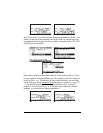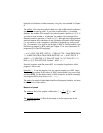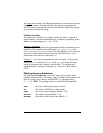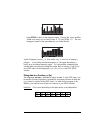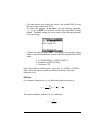
Page 18-6
Definitions
To understand the meaning of these parameters we present the following
definitions
: Given a set of n data values: {x
1
, x
2
, …, x
n
} listed in no particular
order, it is often required to group these data into a series of classes
by
counting the frequency
or number of values corresponding to each class.
(Note: the calculators refers to classes as bins).
Suppose that the classes, or bins, will be selected by dividing the interval (x
bot
,
x
top
), into k = Bin Count classes by selecting a number of class boundaries, i.e.,
{xB
1
, xB
2
, …, xB
k+1
}, so that class number 1 is limited by xB
1
-xB
2
, class
number 2 by xB
2
- xB
3
, and so on. The last class, class number k, will be limited
by xB
k
- xB
k +1
.
The value of x corresponding to the middle of each class is known as the class
mark, and is defined as xM
i
= (xB
i
+ xB
i+1
)/2, for i = 1, 2, …, k.
If the classes are chosen such that the class size is the same, then we can define
the class size
as the value Bin Width = Δx = (x
max
- x
min
) / k,
and the class boundaries can be calculated as xB
i
= x
bot
+ (i - 1) * Δx.
Any data point, x
j
, j = 1, 2, …, n, belongs to the i-th class, if xB
i
≤ x
j
< xB
i+1
The application 2. Frequencies.. in the STAT menu will perform this frequency
count, and will keep track of those values that may be below the minimum and
above the maximum class boundaries (i.e., the outliers
).
Example 1
-- In order to better illustrate obtaining frequency distributions, we
want to generate a relatively large data set, say 200 points, by using the
following:
Θ First, seed the random number generator using: RDZ(25) in ALG mode,
or 25 ` RDZ in RPN mode (see Chapter 17).
Θ Type in the following program in RPN mode:
« n « 1 n FOR j RAND 100 * 2 RND NEXT n LIST » »
and save it under the name RDLIST (RanDom number LIST generator).




